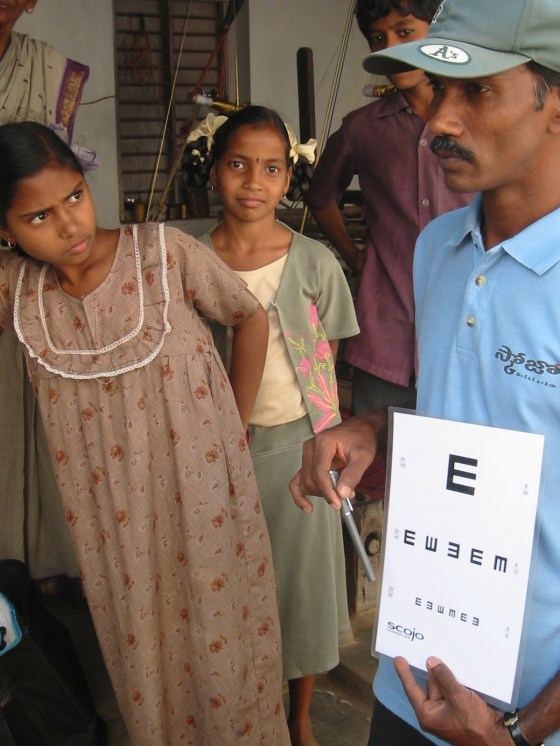 Last month, I took my daughter Lulu in for an eye exam because she was having some trouble seeing. It turned out she did need glasses, so we got her a pair of simple DKNY frames, in plastic, with none of the fancy reflexive coating. Even with our insurance paying 30%, the cost was over $300. Lulu turned to me and said incredulously, “What do poor people who need glasses do?”
Last month, I took my daughter Lulu in for an eye exam because she was having some trouble seeing. It turned out she did need glasses, so we got her a pair of simple DKNY frames, in plastic, with none of the fancy reflexive coating. Even with our insurance paying 30%, the cost was over $300. Lulu turned to me and said incredulously, “What do poor people who need glasses do?”
Good question. And one which the irrepressible Acumen Fund ww.acumenfund.org has taken on. A little background here: The Acumen Fund was started in 2001 by Jacqueline Novogratz to bring innovative entrepreneurial approaches to problems of global poverty. The idea of applying small amounts of “patient” philanthropic capital and large doses of business acumen to build thriving enterprises that can serve vast numbers of the poor has resulted in the creation of 26 thriving enterprises serving 36 million people throughout South Asia and East Africa.
Vision Spring http://www.acumenfund.org/investment/visionspring.html is one of those Acumen enterprises, based in India, which I am happy to support today. Using a model of wholesale distribution and franchising, Vision Spring recruits and trains Vision Entrepreneurs who are trained to travel from village to village conducting vision camps, checking people’s eyesight, and selling reading glasses that range in cost from $2.50 to $4 a pair, with case and cleaning cloth.
The need is stupendous. Presbytopia, or age-related reduced vision, affects almost everyone over 40 – a fact to which I can sadly attest. It also afflicts 20 million people in India, many of whom depend on their vision for their livelihood – like tailors, weavers, people doing handcrafts or reading. But very few Indians have access to vision services. Watch this video of Vision Spring entrepreneur Rama Devi to see what a typical day of work is like, bringing eye clinics to people who are filled with distrust, superstition, hope and curiosity.
In four years, Vision Spring has sold more than 69,000 eyeglasses and diagnosed and referred an additional 74,000 people with severe eye disorders to eye care clinics. 720 trained Vision Entrepreneurs like Rama travel throughout their franchise areas and are hard at work earning a living, while bringing an invaluable health benefit to the people they serve. Looks like a clear win/win proposition to me.


I don’t know about this organization but Lion’s Club International does a used eye glasses project around the world. In my town, a person can drop off their old glasses at our newspaper office. Not only does the newspaper take the glasses to Lion’s club but usually put the person’s name in the paper that donated them!
i always use my eye glasses specially when working in front of the monitor for long periods of time”.:
I just came back from Cambodia where I bought a brand new pair of glasses with a case and cleaning cloth for $10 in a retail shop. I wonder what the total cost of sending used glasses around the world equates to, versus helping people afford the surprisingly good services in their own countries.
I know Cambodia may be ahead of the curve on this one. I just wanted to add this perspective, after being pleasantly surprised myself, and to counter the notion that $300 is the norm elsewhere.
Good point! I have no idea what the cost of glasses are around the world — the reason I love Vision Spring so much is that it works for the people who are becoming Vision Entreprenuers, and earning money .. while it’s providing a good service to the people who have no other way of assessing their vision needs — or getting affordable glasses. And since I can’t see without my readers, I can’t even imagine what it’s like to try to do handiwork without them !
all the best (and wasn’t Asia amazing???) hope i get to see your photos! B
Compared it to what I read in the NYT recently ( http://bit.ly/5dww4P ). So good to read that clever thinking and true empathy steal a march on disconnected technologists, and bring true value to the lives of many.
I have interpreted your post from a business design angle: the less well-off in this world generally have a lack of access to solutions. In the NYT article, featured technologists try to provide a solution to the problem of bad eyesight. In your article, VisionSpring tries to provide a solution to the problem of bad access to eye care.
Yeah! let’s hear it for Acumen Funds! take care — B
What a thoughtful blogpost! Thanks for bringing attention to the good work of Vision Spring. I really do believe that we’re going to see more and more innovation in the developing world that we should examine and consider as potential models for solving problems in the US and Europe.
I like how your daughter thinks as well!
Jacqueline
I’m an Acumen believer and so impressed by what you are doing — it just makes SO much sense that there are viable business models to be created to serve the billions of
people who need affordable products and services ….if only they can get the start-up help they need. And you’re helping to provide that!!! How awesome, B